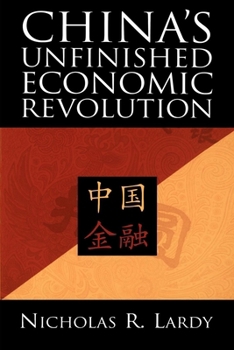China's Unfinished Economic Revolution
Select Format
Select Condition 
Book Overview
" China's Unfinished Economic Revolution offers a fundamentally different interpretation of China's economic reform. The common view that China's gradualistic approach has served it well overlooks the fact that state-owned banks for the last two decades have channeled a large share of sharply rising household savings into what are mostly unreformed, money-losing companies. The result is that several of China's largest financial institutions now...
Format:Paperback
Language:English
ISBN:0815751338
ISBN13:9780815751335
Release Date:July 1998
Publisher:Rlpg/Galleys
Length:342 Pages
Weight:1.10 lbs.
Dimensions:0.8" x 6.0" x 9.0"
Customer Reviews
2 ratings
needs an update
Published by Thriftbooks.com User , 18 years ago
It is now 8 years since this book came out. China has continued to astonish the world with its rapid growth, which certainly does not exclude its banking system. Under these circumstances, an update of this book would be timely. The issues discussed are still germane. Though today's numbers would be expected to be larger. As I write this, just a few days ago, a major Chinese bank had a very successful IPO. It appears that the key issue of bad loans is being gradually ameliorated by policies of the major banks and, implicitly, by the Chinese government, through repeated capital injections.
Timely, critical but not theoretical enough
Published by Thriftbooks.com User , 25 years ago
This timely book by Lardy explains: 1) the intermingling of China's gradualist reform, the inefficiency of SOE and the evolving banking system; 2) the structure and practise of the banking system of China; 3) some of the implications of the looming financial crisis in China. It thus serves as a critical and timely piece for readers to gauge what has been wrong for China and why are the policy implications. There are a few points worth highlighting. First, the cost of the gradualist reform approach is the resulting inefficiency in SOE and the related banking crisis, a cost which is usually forgot in the debate on the pace of reform for emerging economy. Second, the relative size of SOE in China, despite all the measures to stimulate private sectors for the past two decades, is still large, particularly from the perspective of bank lending. This has been reducing the strength of the banks and limiting the availability of funds to private enterprises. Third, due to the lack of other forms of investment, Chinese banking system has absorbed most of the saving from the private sector. However, because of the fragile banking system, deposit rate has been politically controlled at a very low level. This is effective taxing the Chinese household and subsidising the borrowers, i.e. the inefficient SOE. Forth, related to the third point, liberalisation of capital market will post a serious threat to the banking system because it will take away the funding source from the banking system. Fifth, the Asian flu would post limited short term threat to the Chinese system primarily because it is still a closed system. However, long term implication is clear and the Chinese leaders are aware of the similarity of the Chinese symptoms to those of the Asian flu. The only problem from this reader perspective is the level of theoretical underpinning. The piece is full of details in most of the aspects it is addressing. The missing piece however is that it fails to put the banking crisis into a larger perspective of the transformation of socialist system. Although a full discussion in this aspect may perhaps require an entire book itself, a brief discussion seems appropriate given that Lardy commented on some of the more theoretical aspect of the study in Chapter 5.






